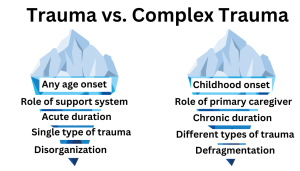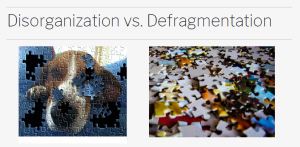The Substance Abuse and Mental Health Services Administration (2014) defines trauma as “an Event, series of events or set of circumstances that is Experienced by an individual as physically or emotionally harmful or life threatening and that has lasting adverse Effects on the individual’s functioning and mental, physical, social, emotional, or spiritual well-being.”
The key to this definition, as pointed out by SAMHSA, is the three e’s: event, experience and effects. An event could include extreme threat or harm and occur once or repeatedly over time. One thing to note is that an event itself does not cause trauma, it is how one experiences it that does. For example, a child removed from an abusive home could experience removal differently than their sibling. How an individual assigns meaning to an event contributes to whether an event is deemed traumatic. Experiences become traumatic when they overwhelm our ability to cope. An event is generally traumatic if there is a feeling of powerlessness, humiliation, guilt, shame, and/or betrayal. If the experience is long-lasting an individual could experience toxic stress.
The last e addresses the effects of the event. Effects may occur immediately or over a period of time. They can be short-term or long-term and typically affect health and well-being. A common example is that there is a change in how a person views themselves, others, and the world around them. The world is no longer a safe place, people can’t be trusted, and they are no longer worthy of care.

Types of Trauma
There are three different types of trauma that we are going to discuss: acute, chronic, and complex/relational (NCTSN, n.d.).
Acute trauma is a single traumatic event that has a one-time occurrence. During this type of event children go through a variety of feelings, thoughts, and reactions that are frightening (NCTSN, 2020). This could be a natural disaster or a car accident.
Chronic trauma on the other hand is experiencing multiple traumatic events (NCTSN, 2020). An example might be a victim to community violence or war.
Complex trauma/relational trauma has the greatest impact because it is chronic trauma starting at an early age that is usually caused by a caregiver (NCTSN, 2020). This type of trauma affects every aspect of a child’s development and functioning having immediate and long-term effects. Examples include neglect and sexual, physical, or emotional abuse by a parent. Complex trauma has the greatest impact on the lives of youth.
Trauma vs. Complex Trauma
To better understand trauma vs. complex trauma let’s look at a comparison between the two.
When comparing trauma vs. complex trauma, what we see is that trauma can have an onset at any age, it affects how the support system functions, has an acute duration (short), generally is a single type of trauma, and overall causes disorganization. On the other hand, complex trauma has a childhood onset, is caused by the role of the primary caregiver, is chronic in duration, persists for many years, is composed of many experiences of trauma, and causes defragmentation (Tello, 2017).

Disorganization vs. Defragmentation
To understand the difference between disorganization and defragmentation we will use a puzzle as an analogy. Disorganization from trauma is like the first image below. They have a frame, represented as the border, and other major pieces in place. A person who has suffered from trauma will still generally understand who they are, how to interact with the world, and the people around them. When looking at defragmentation from complex trauma we can compare it to a pile of puzzle pieces. This is because the person doesn’t understand the world or who they are as an individual. There isn’t a frame or major pieces in place. A great thing however is that with the help of caring adults, youth can start to build the border of their puzzle and put pieces together (Tello, 2017).

In further blogs, we will discuss how adults, who work with youth, can help support youth who may or may not have experienced trauma.
 0
0

